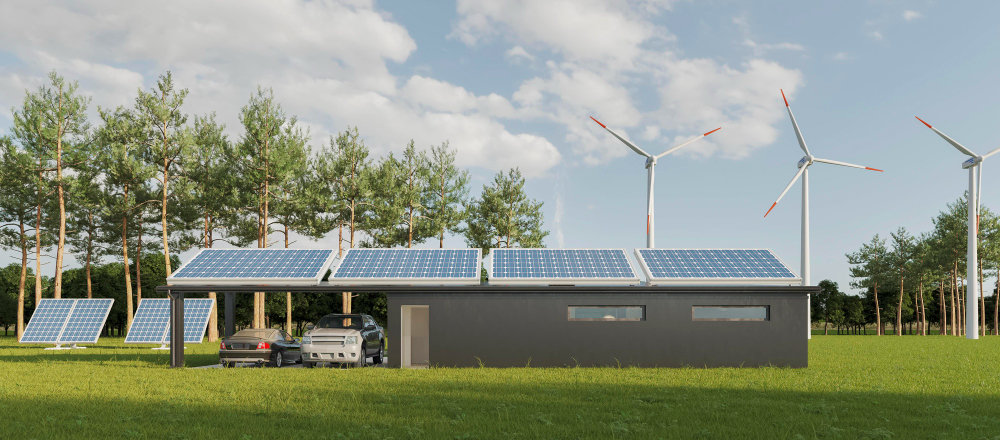3.5.2 Solar Charging of Electric Vehicles
Course subject(s)
3. Smart Charging and Integration of Electric Mobility

This image is from freepik
This lecture discusses solar charging for electric vehicles. The following topics will be covered:
- Two different ways of implementing solar charging of EV
- The benefits of integrating solar energy and EV charging on DC that come with the different implementations
The implementation of solar charging of EV
Roughly speaking, there are two mains to implement solar charging for electric vehicles. These options are onboard, where the solar panels are installed on the vehicle itself, and offboard, where the solar panels are installed of nearby buildings or parking lots.
Onboard charging
For onboard solar charging, the typical drivetrain is shown in the figure below. The solar panel is connected to a unidirectional (Maximum Power Point Tracker) MPPT converter, which allows the solar panel to operate on its maximum power point (MPP) and provides the correct voltage for the high voltage bus inside the EV. After this, there is a bidirectional DC-DC converter that can send power to the battery of the car or provide energy from the battery to the motor. Finally, another DC-DC converter is used to provide a low voltage for other applications, such as lights, displays and windows.

The advantage for charging the EV onboard, is that the EV can be charged both when it is parked and when it is driving. The ability to charge continuously can allow for smaller batteries in the EV. A lower battery then results in a lower weight of the vehicle, which decreases the energy consumption of the car. Therefore, charging onboard can improve the energy efficiency of the electric vehicle.
An example of an electric vehicle that uses onboard charging, is the Lightyear One. It contains 5 m2 of integrated PV panels, which provide a driving range of 70 km per day. The driving range is of course dependent on the amount of sun light and is lower on cloudy days. The car only requires 83 Wh of energy per kilometre, which results in a high driving range of 725 km.
Offboard charging
The other option is to install the PV panels offboard. In this case, PV panels can be placed on parking lots or nearby buildings. A DC-DC converter is used make the PV panel operate on its MPP. After this a DC-AC converter is used to convert the DC energy into AC energy with a frequency of 50 of 60 Hz, which can then be fed to the grid. The energy from the grid can then be fed to the EV, where either an onboard AC charger is present or an offboard AC-DC converter is used.
This method has one crucial disadvantage. Since PV and EV are both working with DC power, it is unnecessary to convert the DC power to AC power and reverse this later. This introduces additional losses and requires more power electronics. A more efficient method would be to directly exchange DC power from the PV panels to the EV, such that the DC-AC converter and AC-DC converter can be merged. An additional DC-AC converter can be used to also feed energy to the grid. This solution is shown in the figure below.
As an example, at the TU Delft, a 10kW solar powered direct DC charger is developed. It has three power converters, a DC-to-DC converter for the solar panels, a DC-DC isolated converter for the electric car and a DC-to-AC inverter to connect to the AC grid.
This design has multiple advantages:
- There is direct DC charging, without converting it into AC power.
- Only one DC-AC charger is used for both the solar panels and the electric vehicle.
- The electric vehicle can be used for vehicle-to-grid (V2G), since bidirectional DC-DC converters are used.
- Four different flows of power are able due to the DC system. This are the following flows:
- PV to EV: Solar panels charge the electric vehicle.
- EV to grid: The vehicle is used for V2G to give energy to the grid.
- Grid to EV: The vehicle can be charged by the grid on cloudy days.
- PV to grid: The PV system can feed its energy to the grid if there are no cars.
Conclusion
This lecture discussed two different methods for allowing solar charging for electric vehicles. These implementations where onboard and offboard. For each of the implementations, the benefits were covered.

Technology of Intelligent and Integrated Energy Systems by TU Delft OpenCourseWare is licensed under a Creative Commons Attribution-NonCommercial-ShareAlike 4.0 International License.
Based on a work at https://online-learning.tudelft.nl/courses/technology-of-intelligent-and-integrated-energy-systems/



